
Pyrgus is a genus in the skippers butterfly family, Hesperiidae, known as the grizzled skippers. The name "checkered" or "chequered skipper" may also be applied to some species, but also refers to species in the genera Burnsius and Carterocephalus. They occur in the Holarctic with an additional group of species extending to the Neotropic.

Schinia, commonly called flower moths, is a large genus of moths belonging to the family Noctuidae. The genus has a Holarctic distribution with the vast majority of species being found in North America, many with a very restricted range and larval food plant.

Baetica ustulata is the only species of bush crickets in the monotypic genus Baetica.

Zygaena fausta is a member of the family Zygaenidae, the day-flying burnet moths. Its bright aposematic colours of red, white and black on the wings indicate to possible predators such as birds that it is foul tasting or poisonous. In flight, the bright red abdomen is revealed, contrasting with the white legs and black head and antennae; the thorax is black and white with an eye spot on each side. There appears to be a considerable variation in pattern among specimens from different parts of Europe.

Heliothis peltigera, also known as the bordered straw, is a species of moth of the family Noctuidae.
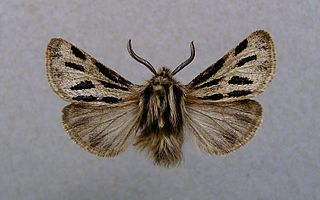
Ocnogyna is a genus of moths in the family Erebidae from western Eurasia. The genus was erected by Julius Lederer in 1853. One aberrant species, Ocnogyna parasita, has females with non-functional wings, and because of this was formerly placed in its own genus Somatrichia, but is now in Ocnogyna.
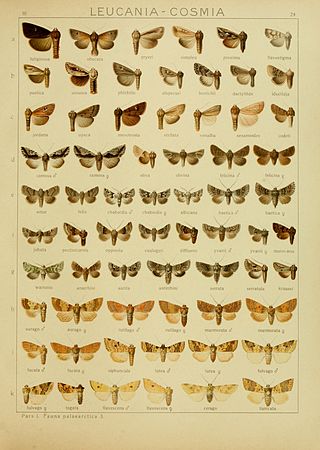
Cleonymia baetica is a moth of the family Noctuidae. It is found from south-western Europe and North Africa, south-east Turkey, Iraq to southwest Iran, it is also known from Saudi Arabia, Jordan, Syria and Israel.
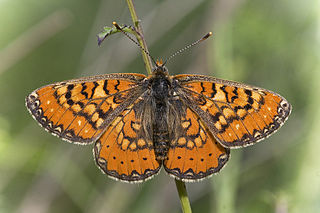
Euphydryas desfontainii, the Spanish fritillary, is a species of butterfly in the family Nymphalidae. It is found in France, Portugal, Spain, Morocco and western Algeria in North Africa.

Zygaena punctum is a species of moth in the family Zygaenidae. It is found in Poland, the Czech Republic, Slovakia, Austria, Slovenia, Italy, the Balkan Peninsula, Moldova, Ukraine, Russia and Turkey.

Eupithecia ericeata is a moth in the family Geometridae first described by Jules Pierre Rambur in 1833. It is found in most of southern Europe and the Near East.
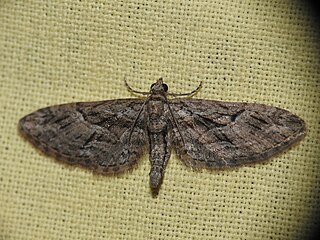
Eupithecia oxycedrata is a species of moth in the family Geometridae. It is found in Spain, southern Portugal, the Balearic Islands, southern France, Corsica, Sardinia, Sicily, Malta, Italy, Slovenia, Croatia, Bosnia and Herzegovina, Montenegro, North Macedonia, Bulgaria, Greece, Crete, western Romania and the Crimea. It is also found in North Africa, from Morocco to Tunisia, and in Turkey. The habitat consists of dry maquis, especially where junipers grow.
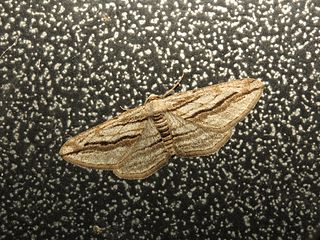
Ecleora solieraria is a moth in the family Geometridae. It is found in France, Andorra and Spain.

Larentia malvata is a moth of the family Geometridae. It was described by Rambur in 1833. It is found in Portugal, Spain, France, Italy, Croatia, Greece, as well as on Sardinia, Corsica, Sicily, Malta and Crete.
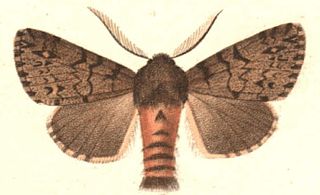
Lymantria atlantica is a moth of the family Erebidae. It was described by Rambur in 1837. It is found in Spain, Portugal and France, as well as on Corsica, Sardinia, Malta and Crete. Outside of Europe, it is found in North Africa. The habitat consists of garrigue-like scrub and coastal areas.
Ocnogyna advena is a moth of the family Erebidae. It was described by Johan Christian Fabricius in 1787. It is found in North Africa.

Ocnogyna corsicum is a moth of the family Erebidae. It was described by Jules Pierre Rambur in 1832.

Ocnogyna parasita is a moth of the family Erebidae. It was described by Jacob Hübner in 1790. It is found in the Alps, the Black Sea region, the Balkan Peninsula, Asia Minor and southern Russia.
Ocnogyna pudens is a moth of the family Erebidae. It was described by Hippolyte Lucas in 1853. It is found in North Africa.

The Ephippigerini are a tribe of bush crickets in the subfamily Bradyporinae, erected by Brunner von Wattenwyl in 1878. Species have been recorded from mainland Europe, North Africa and the Horn of Africa.
Amphiestris is a monotypic genus of European bush crickets in the tribe Tettigoniini, erected by Franz Xaver Fieber in 1853. Records of occurrence are from the Iberian peninsula and North Africa.

















